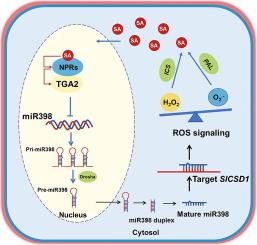miR398-SlCSD1模块参与茄SA-H2O2放大反馈回路
IF 13
1区 综合性期刊
Q1 MULTIDISCIPLINARY SCIENCES
引用次数: 0
摘要
引言水杨酸(SA)是高等植物免疫应答信号转导的必需物质,其信号转导被认为是通过与活性氧(ROS)的相互作用而增强的。本研究报告了miR398b-SlCSD1模块参与番茄(Solanum lycopersicum)SA-H2O2放大反馈环路的情况。采用 CRISPR/Cas9 基因敲除 sly-miR398 和 SlCSD1。生物信息学分析、双荧光素酶报告分析(Dual-Luc)和电泳迁移分析(EMSA)被用来鉴定SA反应性转录因子并验证它们对sly-miR398b的调控作用。结果低浓度的SA刺激了H2O2的积累,增加了超氧化物歧化酶(SOD)的活性,抑制了sly-miR398的表达,而在SA水平降低的NahG植株中却没有这些效应。通过 CRISPR/Cas9 敲除 SlCSD1 部分抑制了 SA 诱导的 H2O2 积累,证实了 SlCSD1 在 SA 依赖性 H2O2 信号转导中的作用。此外,Dual-Luc和EMSA结果显示,TGACG序列特异性结合蛋白2(TGA2)介导了SA对miR398-SlCSD1模块的调控。此外,sly-miR398b 的过表达和突变促进了 SA 通过苯丙氨酸氨解酶(PAL)和异樱桃酸合成酶(ICS)途径的合成,突出了其在 SA 生物合成中的调控作用。这些发现有助于理解 SA-ROS 相互作用,并为通过靶向 microRNA 调控途径增强作物抗逆性提供了一种潜在策略。本文章由计算机程序翻译,如有差异,请以英文原文为准。

miR398-SlCSD1 module participates in the SA-H2O2 amplifying feedback loop in Solanum lycopersicum
Introduction
Salicylic acid (SA) is essential for immune response signal transduction in higher plants, with its signaling thought to be enhanced through interactions with reactive oxygen species (ROS). However, the exact mechanisms behind this SA self-amplifying signaling are still not well understood.Objectives
In this study, we report the involvement of the miR398b-SlCSD1 module in the SA-H2O2 amplifying feedback loop in tomato (Solanum lycopersicum).Methods
Experiments were conducted using various concentrations of SA to assess its impact on ROS metabolism and the expression of SlCSD1 and sly-miR398. CRISPR/Cas9 was employed to knock out sly-miR398 and SlCSD1. Bioinformatics analyses, dual-luciferase reporter assays (Dual-Luc), and electrophoretic mobility shift assays (EMSA) were used to identify SA-responsive transcription factors and validate their regulation of sly-miR398b. The role of miR398 in endogenous SA synthesis was examined using overexpression and knockout tomato lines.Results
Low SA concentrations stimulated H2O2 accumulation, increased superoxide dismutase (SOD) activity, and suppressed sly-miR398 expression, effects absent in NahG plants with reduced SA levels. Knockout of SlCSD1 via CRISPR/Cas9 partially inhibited SA-induced H2O2 accumulation, confirming SlCSD1′s role in SA-dependent H2O2 signaling. Furthermore, Dual-Luc and EMSA results revealed that TGACG-sequence-specific binding protein 2 (TGA2) mediated the regulation of miR398-SlCSD1 module by SA in tomato. Additionally, overexpression and mutation of sly-miR398b promoted SA synthesis via the phenylalanine ammonia-lyase (PAL) and isochorismate synthase (ICS) pathways, highlighting its regulatory role in SA biosynthesis.Conclusion
Taken together, our results shed light on the involvement of the miR398-SlCSD1 module in the SA-H2O2 amplifying feedback loop, providing new insights into SA signaling in tomato. These findings contribute to understanding SA-ROS interactions and offer a potential strategy for enhancing stress tolerance in crops by targeting microRNA-regulated pathways.求助全文
通过发布文献求助,成功后即可免费获取论文全文。
去求助
来源期刊

Journal of Advanced Research
Multidisciplinary-Multidisciplinary
CiteScore
21.60
自引率
0.90%
发文量
280
审稿时长
12 weeks
期刊介绍:
Journal of Advanced Research (J. Adv. Res.) is an applied/natural sciences, peer-reviewed journal that focuses on interdisciplinary research. The journal aims to contribute to applied research and knowledge worldwide through the publication of original and high-quality research articles in the fields of Medicine, Pharmaceutical Sciences, Dentistry, Physical Therapy, Veterinary Medicine, and Basic and Biological Sciences.
The following abstracting and indexing services cover the Journal of Advanced Research: PubMed/Medline, Essential Science Indicators, Web of Science, Scopus, PubMed Central, PubMed, Science Citation Index Expanded, Directory of Open Access Journals (DOAJ), and INSPEC.
 求助内容:
求助内容: 应助结果提醒方式:
应助结果提醒方式:


